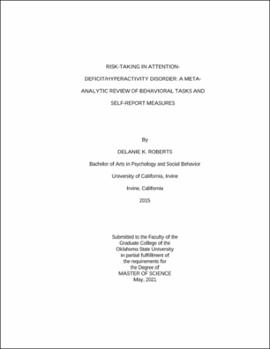| dc.description.abstract | Given characteristic features of ADHD that include behavioral disinhibition (Barkley, 1997), impulsivity (Patros et al., 2016), and increased reward and novelty seeking behaviors (Donfrancesco et al., 2015), it is not surprising that the disorder is also associated with increased risk-taking (Drechsler et al., 2008). The current study used meta-analytic methods to examine group differences in risk-taking between children and adults with and without ADHD, while accounting for the limitations of previous reviews. The present study expands on previous reviews by including a comparison of behavioral tasks and self-report measures of risk taking, and by examining potential methodological and sample moderator variables that were not examined in previous systematic (Groen et al., 2013) and meta-analytic (Dekkers et al., 2016) reviews. Thirty-eight behavioral task studies (ADHDN = 1,197, TDN = 1,178), twenty-nine self-report measure studies (ADHDN = 3,991, TDN = 3,292), and eight virtual reality studies (ADHDN = 214, TDN = 205) provided sufficient data to compute overall between-group effect sizes for risk-taking. Overall, studies using behavioral tasks (Hedges' g = .32, p < .001), self-report measures (Hedges' g = .39, p < .01), and virtual reality simulators (Hedges' g = .63, p = .04) yielded significant medium-magnitude effects, suggesting that children and adults with ADHD exhibited more risk-taking across all task domains, compared to children and adults without ADHD. Two meta-regressions were subsequently analyzed for potential moderating variables in behavioral tasks and self-report measures. Potential sample moderator variables examined in both meta-regressions included age, percentage of females, diagnostic grouping method, comorbid disruptive behavior disorders (DBD), ADHD subtype, and medication use. Potential methodological moderator variables included probabilistic descriptions, choice set size, reward type, and feedback for behavioral tasks, and response format and assessment type for self-report measures. All variables were found to be non-significant moderators in effect size variability. Collectively, these findings suggest that ADHD is associated with moderately greater risk-taking behavior, regardless of task type. Moreover, results suggest virtual reality simulators reality simulators may allow for a more accurate representation of risk-taking behavior exhibited in children and adults with ADHD, compared to laboratory-based behavioral tasks and self-report measures, and findings support the utility of virtual reality simulations in the examination of risk-taking. | |
